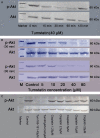Tumstatin 185-191 increases the sensitivity of non-small cell lung carcinoma cells to cisplatin by blocking proliferation, promoting apoptosis and inhibiting Akt activation
- PMID: 26396665
- PMCID: PMC4568790
Tumstatin 185-191 increases the sensitivity of non-small cell lung carcinoma cells to cisplatin by blocking proliferation, promoting apoptosis and inhibiting Akt activation
Abstract
Purpose: This study aimed to investigate the synergistic anti-tumor effects of tumstatin 185-191 and cisplatin in non-small cell lung carcinoma cells (NSCLC) (A549 cells and cisplatin resistant A549/DDP cells), and the potential role of Akt signaling pathway was also explored.
Methods: A549 or A549/DDP cells were treated with Tum185-191 or Tum185-191 plus cisplatin. Cell viability was assessed by modified MTT assay. 50% inhibiting concentration (IC50) and reversing drug-resistance index (RI) of chemotherapeutics were determined by MTT assay. Cell apoptosis was measured by Hoechst 33258 staining and flow cytometry. The activation of Akt signaling pathway was evaluated by immunocytochemistry and Western blot assay.
Results: Tum185-191 inhibited the proliferation of A549 cells and A549/DDP cells. In the presence of Tum185-191 (20 and 40 μM), IC50 of cisplatin reduced significantly in A549 cells and A549/DDP cells. Combined use of tumstatin 185-191 and cisplatin exerted synergistic effects in promoting apoptosis. A549 and A549/DDP cells had a high expression of p-Akt, and Tum185-191, but not cisplatin, significantly inhibited p-Akt expression. Combined use of cisplatin and Tum185-191 failed to further inhibit p-Akt expression. After Tum185-191 treatment, the increased p-Akt expression was observed at 15 min, peaked at 30-60 min, but disappeared at 120 min.
Conclusion: Tum185-191 increases the apoptosis, inhibit the proliferation, enhance the sensitivity of A549 cells to cisplatin and also partly reverse the resistance of A549-DDP cells to cisplatin, which is at least partially mediated by inactivating Akt pathway. These findings provide evidence for the chemotherapy of NSCLC with Tum185-191 and cisplatin.
Keywords: Akt; Non-small cell lung carcinoma cells; Tumstain 185-191; cisplatin.
Figures









References
-
- Siegel R, Naishadham D, Jemal A. Cancer statistics, 2013. CA Cancer J Clin. 2013;63:11–30. - PubMed
LinkOut - more resources
Full Text Sources
